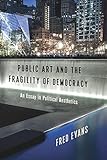Public art and the fragility of democracy : an essay in political aesthetics / Fred Evans.
Material type: TextSeries: Columbia themes in philosophy, social criticism, and the artsPublisher: New York : Columbia University Press, [2019]Copyright date: ©2019Description: 1 online resource (xiii, 342 pages) : illustrationsContent type:
TextSeries: Columbia themes in philosophy, social criticism, and the artsPublisher: New York : Columbia University Press, [2019]Copyright date: ©2019Description: 1 online resource (xiii, 342 pages) : illustrationsContent type: - text
- computer
- online resource
- 9780231547369
- 0231547366
- 320.10922 23
- BH301.P64 .E936 2019
| Item type | Home library | Collection | Call number | Materials specified | Status | Date due | Barcode | |
|---|---|---|---|---|---|---|---|---|
 Electronic-Books
Electronic-Books
|
OPJGU Sonepat- Campus | E-Books EBSCO | Available |
Includes bibliographical references and index.
1. Democracy's fragility and the political aesthetics of public art -- 2. Voices and places: the space of public art and Wodiczko's the homeless projection -- 3. Democracy's "empty place": Rawls's political liberalism and Derrida's democracy to come -- 4. Public art's "plain tablet": the political aesthetics of contemporary art -- 5. Democracy and public art: Badiou and Rancière -- 6. The political aesthetics of Chicago's Millennium Park -- 7. The political aesthetics of New York's National 9/11 Memorial -- 8. Public art as an act of citizenship -- Appendix: Badiou on "being and the void."
Public space is political space. When a work of public art is put up or taken down, it is an inherently political statement, and the work's aesthetics are inextricably entwined with its political valences. Democracy's openness allows public art to explore its values critically and to suggest new ones. However, it also facilitates artworks that can surreptitiously or fortuitously undermine democratic values. Today, as bigotry and authoritarianism are on the rise and democratic movements seek to combat them, as Confederate monuments fall and sculptures celebrating diversity rise, the struggle over the values enshrined in the public arena has taken on a new urgency. In this book, Fred Evans develops philosophical and political criteria for assessing how public art can respond to the fragility of democracy. He calls for considering such artworks as acts of citizenship, pointing to their capacity to resist autocratic tendencies and reveal new dimensions of democratic society. Through close considerations of Chicago's Millennium Park and New York's National September 11 Memorial, Evans shows how a wide range of artworks participate in democratic dialogues. A nuanced consideration of contemporary art, aesthetics, and political theory, this book is a timely and rigorous elucidation of how thoughtful public art can contribute to the flourishing of a democratic way of life.
Description based on print version record.
eBooks on EBSCOhost EBSCO eBook Subscription Academic Collection - Worldwide
There are no comments on this title.

